Author: erkan

Section Of Weapons of Topkapi Palace Museum Istanbul
Section Of Weapons of Topkapi Palace Museum Istanbul,
Going back through the Ward of the second court one encounters to the right the side of the old Divan building. This building, in which are kept collections of weapons, dates from the Conqueror and used to house the Inner Treasury and the Fiscal Treasury. It has seen many restorations. There are some ten thousand weapons of various sorts which have found their way into the Treasury, having belonged either to the sultans or to their retinue and of these six thousand are on display. This is one of the largest collections of Eastern weapons in existence. There is a complete series of Arabic words, each bearing its date, from Muaviye to the last Abbasid Caliphs, and another complete series of Egyptian Mameluk swords, from Baybars to Tomanbay and Kansongori. The Turk-ish swords, of which there is a great variety, ranging from the Conquerer to the last of the Sultans. There are also helmets, coats of armor, shields, maces, lances, javelins, guns and pistols, and a very rich and varied collection of Turkish bows and arrows. The excellence of the Turkish weapons played its role in the great Ottoman victories. At the same time, the delicate ornamentation on them gives them an appearance as harmless as that of any bibelot and reveals the talent for this art of the Turkish craftsmen. The Weapons Section contains separate collections of Persian, European, African and even Japanese weapons. SECTION OF TURKISH TILES (44) The Pen Room under the Dome has been added to from time to time, but it has been finally restored to its original form. A collection of Turkish tiles, which are the most magnificent in the world, is displayed here. Here it is possible to see the development and final decline of this art, from the continue. time of the Selcuk school (fifteenth century) through progressive excellence in the use of color and design to the fall of the curve, and finally to the tiles made for Tekfiir Saray in Istanbul. In addition to the Saray tiles, many other fine examples of this Turkish art are on display in the mosques and tombs in Istanbul and other parts of the country.
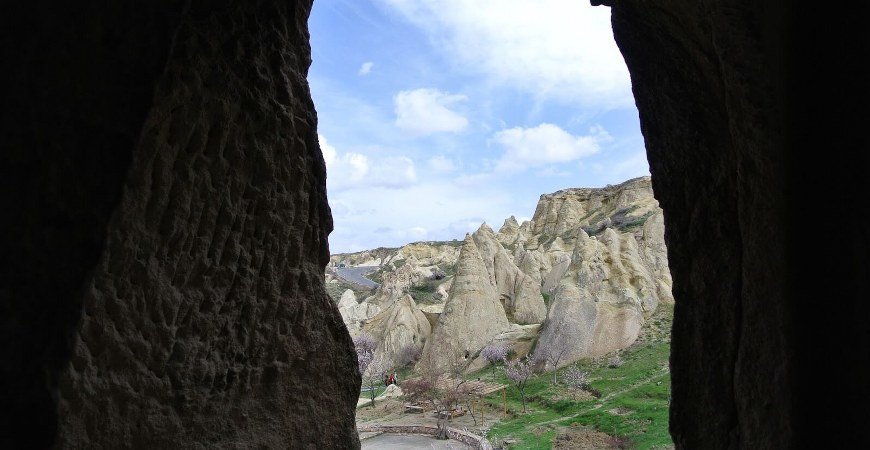
Visit Sights Around Cappadocia Turkey
Visit Sights Around Cappadocia Turkey,
Hacibektas
Formerly known as Suluca Karahoyuk, this town is 45 km north of Nevsehir. The excavations show that it was occupied by Hittites, Phrygians, Romans, and Byzantines. Haci Bektas Veli came here in the 13th century from the province of Khorosan and established the monastery which came to be an important dervish center. The food was cooked in large quantities and he distributed it to the poor and hungry. While doing this, he took the opportunity to teach the principles of Islam and thus gained a great following among the common people. He is buried here and consequently, the name of the town was changed to Haci Bektas. In the 14th century, a place of suffering for religious purposes was built and later expanded. The first restorations were done in the 19th century. From 1954-64 the General Directorate of Foundations carried out extensive repairs and then opened it to the public as a museum. August 16-18 every year is the Festival of Haci Bektas.
Gulsehir And Aksaray
Gulsehir is set on the skirts of Kepez Hill at the side of Kizilirmak Cengeli, which is 20 km northwest of Nevsehir. It is thought that this city was founded by Hittites (II millenium before Christ) by the name of Zoropassos. Then, the name was changed by Greeks to Arabusun. After the Turkish Republic was formed, this place was called Gulsehir. It is now a 5.000 inhabitants town of Nevsehir. When you come two kilometers from GuIsehir towards Nevsehir, you meet hundreds of early Christian hiding places which are carved in the rocks and have half-valley shapes. Its called Aciksaray (Open air palace). The pictures, dated VI and VII centuries here are quite damaged yet worth to be seen. At the same place, there’s the St. John church and a 200 meters tunnel joining the two valleys. At Sigirli, Gumuskent, Sivasa and Gostesin villages of Gulsehir there are some underground towns not opened for visit. At Sivasa village there is also a human relief carved on a rock by Hittites, and 300 meters west there is a hierogliphic inscription carved on basalt rock again by Hittites. This is not all of Sivasa; there is also a Byzantine church on the west of the village, carved on a rock. But the frescoes of Jesus, Virgin Mary, and other Saints are partially damaged.

The Topkapi Palace’s Mansions
The Topkapi Palace’s Mansions,
The Mecidiye Kiosk
This building is sometimes also called the New Kiosk. It is in the French style and was built by Abdul Mecit before the palace of Dolma BO-we, on the site of the old Guards’ Kiosk. Parts of the original structure, dating back to the Conqueror, were incorporated into the new. The furniture is in keeping with the period and is mostly French.
Chief Physicians Room
This tower is thought to have been at one time a tower defining the outer extremity of the New Palace It has been greatly restored and now houses a collection of the medicines, medical books and medical instruments of the day. Since the bash lala, or head tutor, was always present at the preparation of medicines it is also sometimes referred to as Lala Tower.
The Sofa Kiosk
This kiosk is built on a high terrace, in palace terminology known as a sofa, hence the name. In the front garden. The kiosk was built in 1704 mid repaired III 1752. It consists of two rooms, one I-II die for small, with windows opening round on The walls and ceilings, ornamented with gilt are among the most charming examples Tor 11 h rococo.
The Revan Kiosk
This kiosk was built in 1635, during the reign of lanai IV, to commemorate the capture of Revan. The kiosk, built in three wings, is decorated inside mid out with tiles of the period. The wooden arches delicate woodwork of the ceilings are things which it is seen elsewhere.
The Bagdad Kiosk
This kiosk was built in the reign of the same Sultan, in 1638, to commemorate the conquest of Bagdad, and was probably constructed by Kasim, the chief architect of his time. It consists of two rooms, one large, the other small, built over high vaults and surrounded by broad leaves and a colonnade. The larger room is domed and has four wings. Three doors lead away from it. The walls are lined inside and out the tip to the edges of the dome with the most beautiful I is of the period. The doors, windows, and cupboards are worked in tortoise shell, and mother of pearl. The dome itself, decorated with roses and other flowers in relief against a red background, is a rare work of art. The kiosk also possesses a majestic fireplace, with bronze steps leading to it.
The Treasury of Topkapi Palace Museum in Istanbul – Chapter 2
The Treasury of Topkapi Palace Museum in Istanbul – Chapter 2,
In this manner, a charming example of Mehmet the Conqueror’s fine taste in architecture has been brought to light. In three rooms of this kiosk part of the Ottoman, the treasure is now on show. In the second room, there is the throne made in the time of Murat III, adorned with topazes set in gold. This throne was used up to the time of the last Sultan for accession ceremonies, festivals and other occasions. The throne of Ahmet I. adorned with tulips and carnations of mother-of-pearl, set in tortoise-shell and studded with rubies, turquoises, and emeralds possess an enormous emerald pendant and device of exceptional rarity. The throne of Murat IV is made of ebony covered with ivory and mother-of-pearl work of the highest artistic skill. This throne was used in the Bagdad campaign. Also on display is the attire of sever-al of the Ottoman emperors with costumes and plumes of the period : Sultan Mehmet II the Conqueror, Sultan Selim I the Inflexible, Sultan Suleyman I the Magnificent, Sultan Mehmet III, Sultan Ahmet I, Sultan Murat IV, Sultan Selim III, Sultan Mahmud II, Sultan Abdul Mecit, Sultan Abdul Hamit II, the jewelled armour and weapons of Murat IV, plumes, the uniform of the lifeguards, quivers and bow cases, jewelled swords, helmets, arrows, shields, jewelled daggers, jewelled rifles and revolvers. In the third room (24) are displayed jeweled writing-sets made of various materials, inkwells, pen cases. pen knives, jeweled centers, the casket containing the Hirka-i-Saadet (The Holy Mantle of the Prophet), jeweled mirrors and fans, pearled prayer-car-pets and gold candlesticks, prayer beads of pearls and emeralds, a gold cradle studded with precious stones, jeweled girdle and other jeweled and enameled objects. Also to be seen are Ottoman medals and decorations; foreign medals and decorations set with precious stones, which had been presented to Sultans Abdul Mecit, Abdul Aziz, and Abdul Hamid II; the throne carpets and hanging from the Arzodasi. (Hall of Petitions), adorned with pearls, emeralds and rubies and having fringes of gold; the throne of pearls, emeralds, and rubies which formed part of the booty won in the caldera campaign; a throne of emeralds and rubies; and finally the hand and, in a casket adorned with emeralds, the skull of the Prophet Yahya.
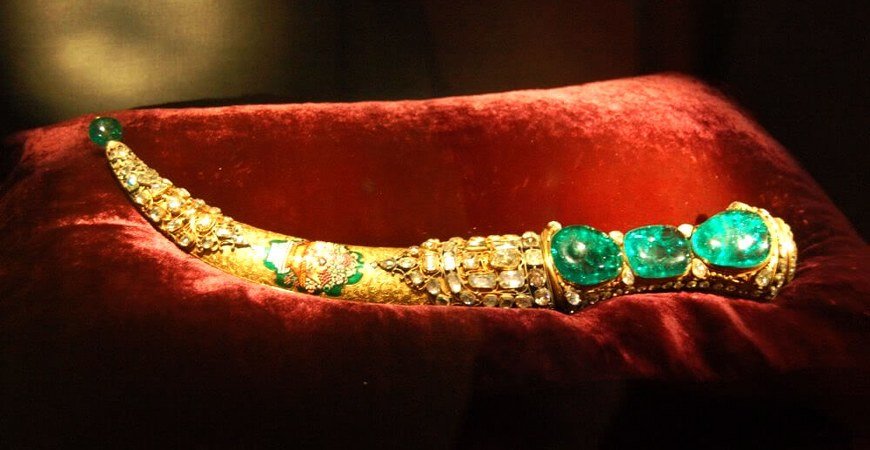
The Treasury of Topkapi Palace Museum – Chapter 1
The Treasury of Topkapi Palace Museum – Chapter 1,
Throughout the centuries the Ottoman sultans gathered into what was known as the Imperial Treasury, the Rulers’ or the Inner (Enderun) Treasury, innumerable objects of inestimable value both from a historical and artistic point of view and from the point of view of the magnificence and wealth which they represented. From this inexhaustible fund, the sultans made frequent gifts to those of their subjects they wished to gratify. The first part of the treasure is housed in the dressing room of the Hamam already mentioned. The enormous dome, the stalactite niches, the plaster work on the windows, are features of this building which testify to its being an architectural masterpiece. Its chief claim to historical importance is it’s having been the scene of the death of Selim II. In this room (22) which had fallen into ruin and was subsequently restored, can be seen jade objects of many different periods, ornamented with emeralds, rubies, and diamonds; unique zinc pitchers and drinking cups, writing sets made of rock crystal decorated with pro curious stones, the earliest dating back to the Fatimi period; oil lamps, a collection of pipes and narghiles, watches and clocks, gold and jade book covers, all studded with precious stones; similarly adorned coffee cups, spoons, snuffboxes, combs, belts and finally a magnificent collection of prayer beads. The second se3tion of the treasure is in one of the loveliest of the kiosks built by Mehmet II, overlooking the Marmara and the Bosphorus. The boundless booty and wealth brought here by Selim I filled the kiosk to overflowing, and with time its doors and windows were blocked up and additional space for treasure was added, so that the little building became unrecognizable. In recent years it has been restored, its splendid front gate and windows have been opened and the columns of the front portico dug out of the wall in which they had been encased. The gratings and walls around the portico of the kiosks have been taken down so that from here one can watch in fascination an unparalleled panorama stretching from the Marmara to the Bosphorus.
You can continue to find more details about The Treasury of Topkapi Palace Museum in Chapter 2.
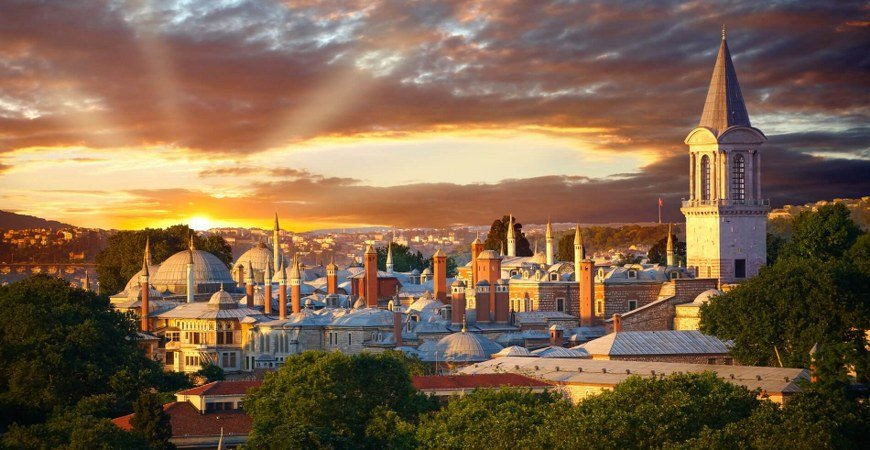
Section of Calligraphy, Illumination and Miniatures of Topkapi Palace
Section of Calligraphy, Illumination, and Miniatures of Topkapi Palace,
Part of this building occupies the site of the Conqueror’s magnificent bathhouse. Under Ahmet III a broad-leaved building was built here to house the Campaigners Ward. This was pulled down under Abdul Alma, and the present stone building erected in its place. This building was for the use of the servants who waited upon the sultan during military campaigns, as well as for the turban-winders, laundrymen, and barbers who served him in peacetime. During the reign of Sultan Mehmet V one floor was taken out and a number of Chinese porcelains exhibited here. When the Saray became a museum the porcelain was re-classified, and after the restoration of the kitchens moved to the more suitable premises there. The collection on show in this building starts with a manuscript written on papyrus and bearing the date 708. This is followed by the works of Ibn-i-Bevap, Yakutel Mustahsani and their disciples, On the wall to the right and in a showcase in front of it can be seen beautiful examples of the calligraphy of Seyil Hamdullah of Amasya (1436 – 1520) who brought about an in this art. This is followed by exhibits of the work of Mustafa Dode (Seyh Hamdullah’s disciple), Karahisari, Mehmet Rasim, Dervish Ali, Mahmut Celaleddin, Kazasker Mustafa Izzet, Shefik and Mustafa Shevki, each of whom had his school of followers, down to the last Master of Calligraphy, Kamil Akdik. For examples of the Persian style of calligraphy, there are the works of Yesari and of other masters. There are also examples of Guidry calligraphy and of carved lettering, arranged in chronological order. In the left wing, each a work of art in itself, are ranged the tundra (monograms used as seals) of the sultans, from Orhan to Mehmet VI, with the sole exception of Bayezit the Thunderbolt. On the wall opposite are scrolls bearing the handwriting of various sultans and in front of this an exhibit of the differ-ent implements used in calligraphy pen and ink cases, inkstands, pen rests, rulers and scissors On the right-hand side of the hall is a chronological display of lacquered and ornamented bookbindings, beginning with Seljuks. On the left-hand side, there is an enormous collection of Turkish miniatures, from the thirteenth to the eighteenth centuries. In the second hall, we find Persian calligraphy, illuminations and miniatures, as well as Cufic, Moroccan and Mameluk calligraphy and Indian miniatures. In both wings of this hall are to be found doors, reading desks and other objects illustrating the woodcarving and mother-of-pearl inlay work of the fifteenth to the nineteenth centuries. The works displayed in this hall from one of the rarest and largest collections of its kind in the world. Yet they have been selected from among thousands more, which are kept in the Saray Library.
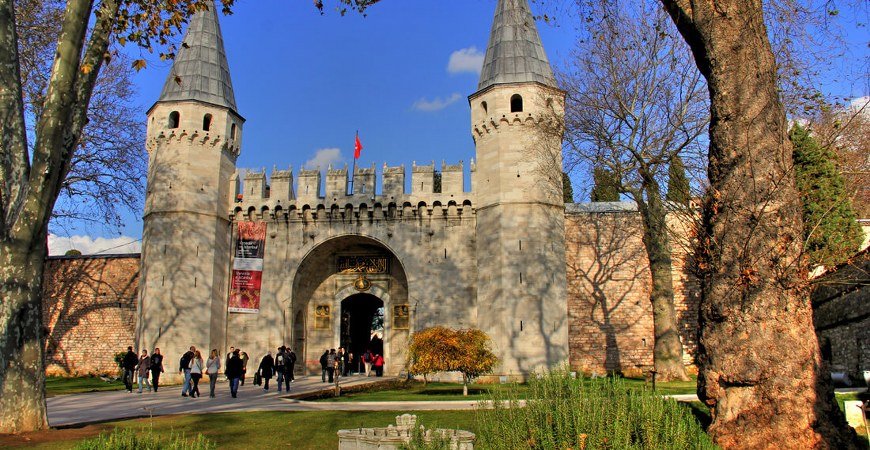
About Istanbul Topkapi Palace
About Istanbul Topkapi Palace,
Gate Of The Acias:
This gate is also known as the Gate of Felicity, and the Gate of Petitions. Slender marble columns pit sport, its roof. It was built during the reign of Selim Ill. On the accession of each new sultan, a ceremony took place here. Seated upon a throne of gold the new sultan took the oath of allegiance. These ceremony wits continued up to the accession of the last monarch. Another ceremony took place at this- same gate every Bityram. Here, too, outdoor meetings of the Divan wore occasionally held, and violent incidents of Ottoman history took place. Another ceremony, held here whenever war was declared, was that of the handling of the Banner of the Prophet to the commander of Ilic armies The guarding of this gate was entrusted II) the Ak, or White, Agas. Beyond it lay the living quarters of the Aga of the Gates on one side, and the dormitories of the White Agas on the other. This gate Acias to the third court, known as Enderun (Inner Court). From here on one was in the palace proper. The structures leading to this court were known as It’s run or outer section.
Audience Chamber:
This colonnaded hall was built in the time of the Conqueror but altered several times until finally, after a fire in the nineteenth century, it lost its original character completely when a partition was put in. In this hall, the viziers submitted their reports to the sultan, and foreign ambassadors were received according to a strict protocol. On such special days, the passages leading to the hall were hung with thin gold-embroidered curtains, and precious rugs and tapestries were placed upon the floor. Above the throne were suspended enormous emeralds, and the cushions of the throne were embroidered with emeralds and pearls. In 1808 Alemdar Mustafa Pasha led a revolt against the palace and penetrated as far as the Hall of Petitions, only to find there the bloody corpse of Selim III, whom he had been attempting to replace on the throne, who had been murdered in the harem. The throne platform and the fireplace in the Hall of Petitions date from the time of Mehmet the Conqueror.
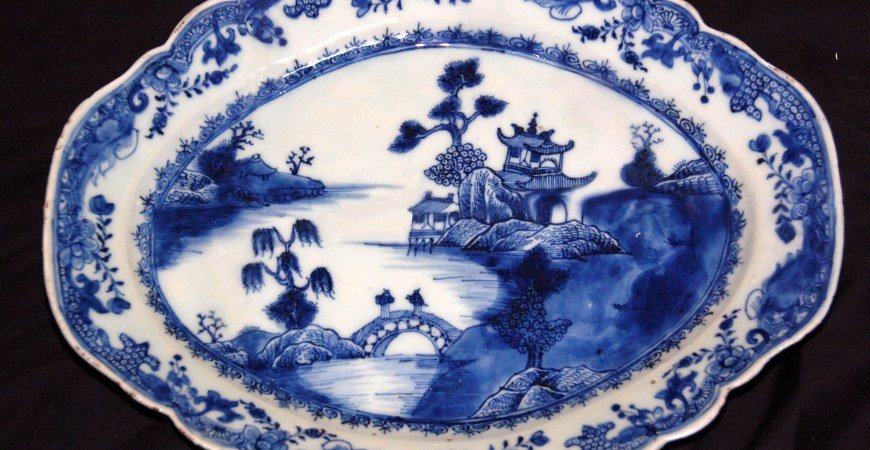
Sections Of Istanbul Topkapi Palace Porcelain And Glasswork
Sections Of Istanbul Topkapi Palace Porcelain And Glasswork,
This section is housed in the building which served as a creamery and was seriously injured in a fire and subsequently restored. In this hall is a large collection of the glass works of Istanbul. The varieties exhibited include ordinary blown glass, crystal, and colored glass, which later came to be known as cesme bill (Nightingale’s Eye, from the colored dots on the glass). In the first hall, the visitor can see the palace oil – lamps, with their designs of gilt•leaf tulips, cesmi Billbill pitchers, and jugs of many colors, tulip – holders, and objects of opaque glass, among the most beautiful of to air kind. Specimens of stained glass, such as can be seen in other buildings and mosques, are also shown here. This series is followed by the earliest porcelain made in Istanbul, bearing a mark to that effect. Although the Turks are second to none in tile-work, they were slow in taking up the manufacture of porcelain, and it was only in 1846 that Ahmet Fethi Pasha, the great founder of the Turkish museums, inaugurated a porcelain factory at Beykoz. This factory was closed upon his death in 1854. Finally, Abdul Hamid had a porcelain factory built in the grounds of his palace of Yildiz. This factory began production in 1896, with the help of two craftsmen imported from Sevres, and soon used entirely native materials for its products. The Yildiz factory produced porcelain of fine design and work-manship, in particular, sets decorated with views by several of the famous painters of the day, and with beautiful gilding. After the declaration of the Con-Hullo ion of 1908 the factory was left unoccupied for a link, then it resumed work with Turkish craftsmen In charge and continued to produce fine porcelain until it was closed for good at the beginning of the 11 a World War. A passage next to this hall leads to the second cum. At the end of it is a door flanked by columns.
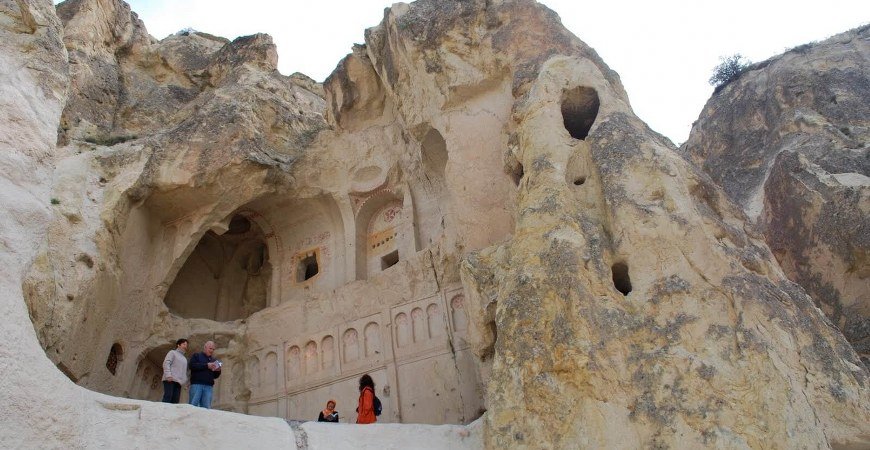
Rock Sites of Cappadocia Region in Turkey
Rock Sites of Cappadocia Region in Turkey,
Zelve
Turning right on the road to Avanos from Goreme one reaches the ruins of Zelve after a drive of 3 km. through a valley filled with fairy chimneys of various types and tall rocks pierced with many holes. Into these rocks were carved during the Byzantine period numerous churches and shelters, the entrances of which are sometimes high above the level of the valley. After the departure of the Byzantines, Turks built a small village in this valley, but had to leave it in 1950 -55 because of the destructive effects of erosion and moved to a new village that was built. The Valley boasts the most interesting and numerous fairy-chimneys of the Cappadocian region.
Avanos
No one knows the exact date of the foundation of the town of Avanos, which is located 15 km from the city of Nevsehir, and falls within its jurisdiction a nomadic tribe of Seljuks moving from east to west led by Bey Evranos settled near the Kizilirmak river south of MT Ziyaret and founded the town which is known today as Avanos. In the beginning, this tribe named the town after its leader EVRANOS but after a time the name was transformed to Avanos. The first inhabitants of Avanos made clay objects water jugs, dishes water storage vessels and other household utensils. Today’s inhabitants of Avanos have kept up this tradition and their pottery is quite renowned. The arts of carpet-weaving are especially important in this touristic area. In more ancient times this region was known as Venessa which means city on the river in Latin. The nearest tourist sights are Sarihan (7 km), Zelve (7 km), Cavusin (16 km), Avcilar (9 km), Goreme (12 km) and Ozkonak (18 km). Tourists are attracted to these towns more than to others.
Sinasos Or Mustafa Pasa
Mustafa Pasa is a small town (pop. 3000) built in a valley 5 km. to the south of OrgOp. This is another settlement where the distinctive construction of the houses attracts the local and foreign tourists. These houses indeed deserve special mention also for the rich decorations around the doors and windows. This place used to be inhabited by Greeks until after the War of Independence. After their emigration, it was settled by Turks and its name (Sineson, Sinosos) was changed into Mustafa Pasa. A two-storey monastery dating from that period now serves as a hotel; the frescoes have been preserved. The church of Ayos Vasilios is at a distance of 1 km. from the town and one enters it by going down a staircase built into the rock. The church itself has been carved entirely out of the rock and four columns support its ceiling. Though not of great historical interest, its frescoes deserve mention.
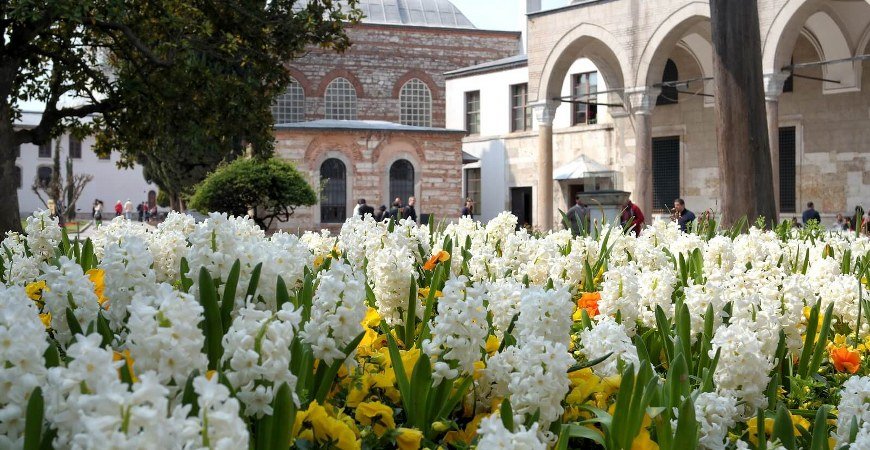
The Topkapi Saray Museum Istanbul
The Topkapi Saray Museum,
The Conqueror’s New Palace lost as many sections in the course of its long history. When the rulers of the empire moved to Dolmabahce and other places elsewhere in the city, their old home came to be known as the Topkapi, or Cannon Gate, Palace. They now visited it only on the occasion of the ceremony of the Sacred Mantle (the Prophet Mohamed met’s mantle) during the holy month of Ramazan. The treasury remained within its vaults, which necessitated the maintaining of a strong guard within the gates. However, little attention was paid to the buildings themselves, which were allowed to become dilapidated. In 1924, after the declaration of the Republic, the Saray was turned into a museum and its gates were opened to the public. Many ruined buildings in this vast enclosure of nearly 700,000 sq. meters were restored, abandoned rooms and kiosks were refurbished, tens of thousands of works of art were classified into various museum sections, thousands of books arranged to form a library and hundreds of thousands of documents were classified and cataloged. The entrance to this Museum, with its majestic historical past, lies behind the Mosque of Ayasofya, past the beautiful fountain which Ahmet III built in 1729, through the Bab-i-Humayun, the Imperial Gate, which leads into the first court, known, as Ow court of Processions. At the other end of this court, a gate surmounted by two peaked towers leads into the Museum.
Silver Section
A great deal of the sultans’ silver was sent to the mints to be melted down so that the items displayed in This section are all later than the seventeenth century. Together with the examples of the work of English, French and other foreign silversmiths to be seen in ibis section, there are also examples of goldsmiths’ work. The objects exhibited give an idea both of the workmanship of the Turkish silversmiths and of the manner of living of the Turks in different periods of history. There is a great variety of these objects, from It) coffee cups, candlesticks, lanterns, mirrors, trays, dishes, coolers, bird – cages, jewel cases and water jugs to dust shovels and funnels. A collection of objects made of gilt, and copper with embossed flower designs (a kind of work known as tombak, is housed in the same hall.
Copper Section
The kitchens of the Seraglio were divided into three sections, referred to as the lower, middle and upper kitchens. We now penetrate into the upper kitchens or the Helva House (a popular Turkish sweet) where the food of the palace elite was prepared.’ The walls of this building are covered with flowered tiles. Here can be seen the kitchen utensils of the Saray, from the enormous cauldrons to an infinite variety of pots and pans, covered dishes and round trays, sieves, mortars, and ladles. On some of these, the inscriptions giving the name of the maker also include the date. Also on display here are dishes, coffee-grinders, knives and spoons made of meerschaum or S(Suleymaniye stone. In one showcase around eighteenth – century silver tray is set with a dinner service typical of those used by the sultans. The sultan’s food was prepared in a separate kitchen, the Kushane, or Birdhouse.